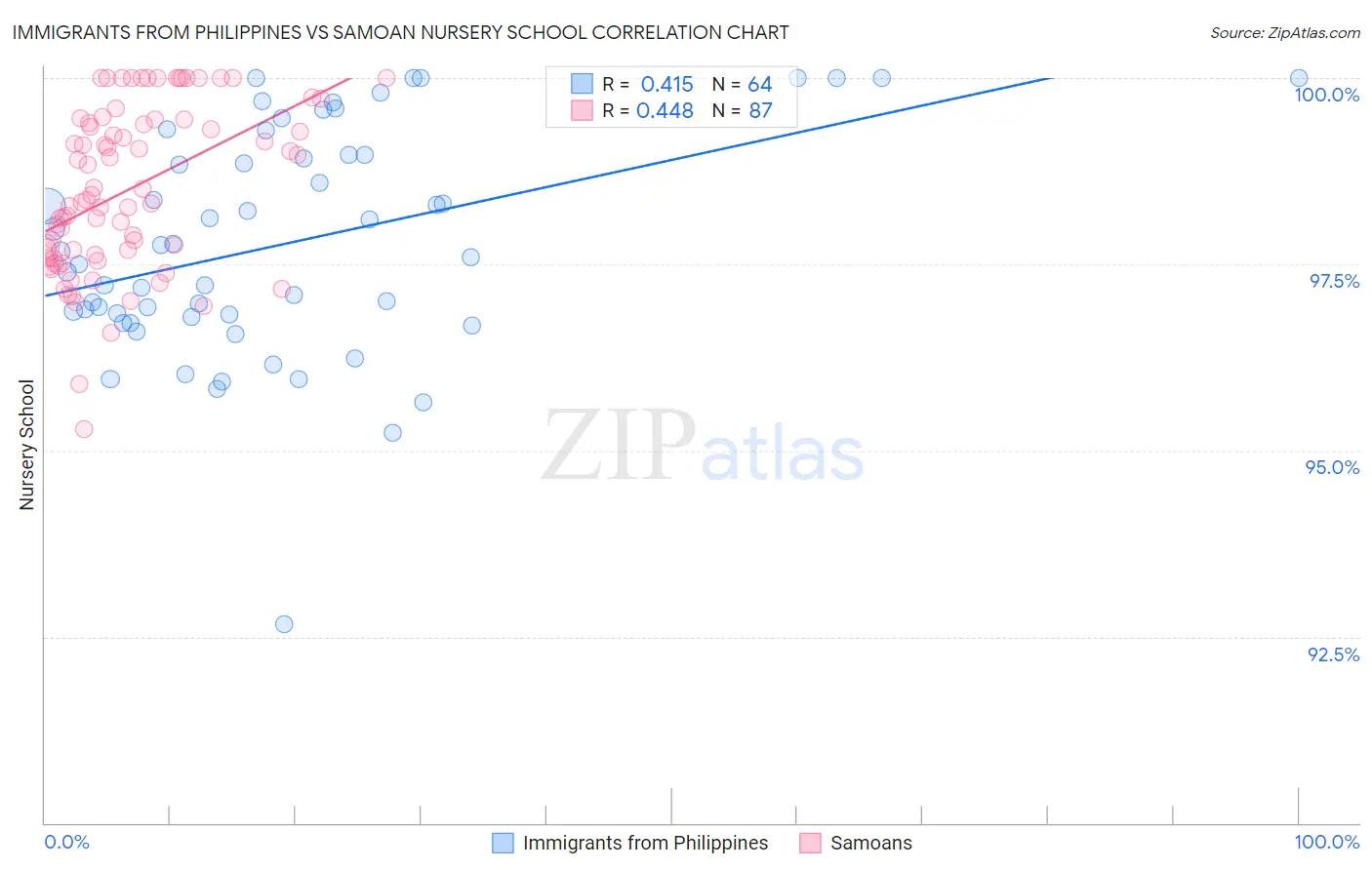Immigrants from Philippines vs Samoan Nursery School
COMPARE
Immigrants from Philippines
Samoan
Nursery School
Nursery School Comparison
Immigrants from Philippines
Samoans
97.5%
NURSERY SCHOOL
0.1/ 100
METRIC RATING
276th/ 347
METRIC RANK
97.8%
NURSERY SCHOOL
6.3/ 100
METRIC RATING
217th/ 347
METRIC RANK
Immigrants from Philippines vs Samoan Nursery School Correlation Chart
The statistical analysis conducted on geographies consisting of 471,303,140 people shows a moderate positive correlation between the proportion of Immigrants from Philippines and percentage of population with at least nursery school education in the United States with a correlation coefficient (R) of 0.415 and weighted average of 97.5%. Similarly, the statistical analysis conducted on geographies consisting of 225,201,431 people shows a moderate positive correlation between the proportion of Samoans and percentage of population with at least nursery school education in the United States with a correlation coefficient (R) of 0.448 and weighted average of 97.8%, a difference of 0.33%.

Nursery School Correlation Summary
| Measurement | Immigrants from Philippines | Samoan |
| Minimum | 92.7% | 95.3% |
| Maximum | 100.0% | 100.0% |
| Range | 7.3% | 4.7% |
| Mean | 97.8% | 98.5% |
| Median | 97.6% | 98.4% |
| Interquartile 25% (IQ1) | 96.8% | 97.6% |
| Interquartile 75% (IQ3) | 99.0% | 99.4% |
| Interquartile Range (IQR) | 2.2% | 1.9% |
| Standard Deviation (Sample) | 1.5% | 1.1% |
| Standard Deviation (Population) | 1.5% | 1.1% |
Similar Demographics by Nursery School
Demographics Similar to Immigrants from Philippines by Nursery School
In terms of nursery school, the demographic groups most similar to Immigrants from Philippines are Immigrants from Western Africa (97.4%, a difference of 0.010%), Immigrants from China (97.5%, a difference of 0.020%), Immigrants from Cameroon (97.5%, a difference of 0.020%), Ghanaian (97.5%, a difference of 0.020%), and Immigrants from Uzbekistan (97.4%, a difference of 0.030%).
| Demographics | Rating | Rank | Nursery School |
| Immigrants | Liberia | 0.3 /100 | #269 | Tragic 97.5% |
| Immigrants | Jamaica | 0.2 /100 | #270 | Tragic 97.5% |
| Immigrants | Peru | 0.2 /100 | #271 | Tragic 97.5% |
| Immigrants | Bolivia | 0.1 /100 | #272 | Tragic 97.5% |
| Immigrants | China | 0.1 /100 | #273 | Tragic 97.5% |
| Immigrants | Cameroon | 0.1 /100 | #274 | Tragic 97.5% |
| Ghanaians | 0.1 /100 | #275 | Tragic 97.5% |
| Immigrants | Philippines | 0.1 /100 | #276 | Tragic 97.5% |
| Immigrants | Western Africa | 0.1 /100 | #277 | Tragic 97.4% |
| Immigrants | Uzbekistan | 0.1 /100 | #278 | Tragic 97.4% |
| Immigrants | Ghana | 0.1 /100 | #279 | Tragic 97.4% |
| Barbadians | 0.0 /100 | #280 | Tragic 97.4% |
| Trinidadians and Tobagonians | 0.0 /100 | #281 | Tragic 97.4% |
| Afghans | 0.0 /100 | #282 | Tragic 97.4% |
| Immigrants | West Indies | 0.0 /100 | #283 | Tragic 97.4% |
Demographics Similar to Samoans by Nursery School
In terms of nursery school, the demographic groups most similar to Samoans are Bahamian (97.8%, a difference of 0.010%), Uruguayan (97.8%, a difference of 0.010%), Immigrants from Panama (97.8%, a difference of 0.010%), Moroccan (97.8%, a difference of 0.020%), and South American Indian (97.8%, a difference of 0.020%).
| Demographics | Rating | Rank | Nursery School |
| Immigrants | Oceania | 10.2 /100 | #210 | Poor 97.8% |
| Laotians | 9.8 /100 | #211 | Tragic 97.8% |
| Immigrants | Bahamas | 8.6 /100 | #212 | Tragic 97.8% |
| Moroccans | 8.3 /100 | #213 | Tragic 97.8% |
| South American Indians | 8.0 /100 | #214 | Tragic 97.8% |
| Bahamians | 7.4 /100 | #215 | Tragic 97.8% |
| Uruguayans | 7.1 /100 | #216 | Tragic 97.8% |
| Samoans | 6.3 /100 | #217 | Tragic 97.8% |
| Immigrants | Panama | 5.3 /100 | #218 | Tragic 97.8% |
| Immigrants | Morocco | 5.1 /100 | #219 | Tragic 97.8% |
| Immigrants | Zaire | 4.4 /100 | #220 | Tragic 97.8% |
| Tongans | 4.3 /100 | #221 | Tragic 97.8% |
| Immigrants | Syria | 4.0 /100 | #222 | Tragic 97.7% |
| Immigrants | Sudan | 3.9 /100 | #223 | Tragic 97.7% |
| Immigrants | Nepal | 3.6 /100 | #224 | Tragic 97.7% |